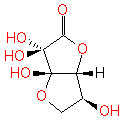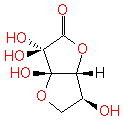|
Record Information |
|---|
| Version |
1.0 |
|---|
| Update Date |
1/22/2018 11:54:54 AM |
|---|
|
Metabolite ID | PAMDB120270 |
|---|
|
Identification |
|---|
| Name: |
dehydroascorbate (bicyclic form) |
|---|
| Description: | Ascorbate is oxidized in cells to dehydroascorbate via the monodehydroascorbate radical. Dehydroascorbate can be recycled back to ascorbate by the ascorbate glutathone cycle, or it can be further broken down in vivo by irreversible reactions.
While the structure of dehydroascorbic acid found in most text books is that of L-dehydroascorbate, it appears that the actual structure in solution is that of a bicyclic monohydrate.. |
|---|
|
Structure |
|
|---|
| Synonyms: | - dehydroascorbate monohydrate
|
|---|
|
Chemical Formula: |
C6H8O7 |
|---|
| Average Molecular Weight: |
192.125 |
|---|
| Monoisotopic Molecular
Weight: |
192.02701 |
|---|
| InChI Key: |
QPPOKIPSRPKDEM-VPGXFDHMSA-N |
|---|
| InChI: | InChI=1S/C6H8O7/c7-2-1-12-6(11)3(2)13-4(8)5(6,9)10/h2-3,7,9-11H,1H2/t2-,3+,6-/m0/s1 |
|---|
| CAS
number: |
Not Available |
|---|
| IUPAC Name: | Not Available |
|---|
|
Traditional IUPAC Name: |
Not Available |
|---|
| SMILES: | C2(=O)(O[CH]1(C(O)(OCC(O)1)C(O)(O)2)) |
|---|
|
Chemical Taxonomy |
|---|
|
Taxonomy Description | This compound belongs to the class of organic compounds known as isosorbides. These are organic polycyclic compounds containing an isosorbide(1,4-Dianhydrosorbitol) moiety, which consists of two -oxolan-3-ol rings. |
|---|
|
Kingdom |
Organic compounds |
|---|
| Super Class | Organoheterocyclic compounds |
|---|
|
Class |
Furofurans |
|---|
| Sub Class | Isosorbides |
|---|
|
Direct Parent |
Isosorbides |
|---|
| Alternative Parents |
|
|---|
| Substituents |
- Isosorbide
- Gamma butyrolactone
- Monosaccharide
- Tetrahydrofuran
- Carboxylic acid ester
- Hemiacetal
- Lactone
- Secondary alcohol
- Monocarboxylic acid or derivatives
- Carboxylic acid derivative
- Polyol
- Carbonyl hydrate
- Oxacycle
- Hydrocarbon derivative
- Carbonyl group
- Organic oxide
- Organic oxygen compound
- Alcohol
- Organooxygen compound
- Aliphatic heteropolycyclic compound
|
|---|
| Molecular Framework |
Aliphatic heteropolycyclic compounds |
|---|
| External Descriptors |
- a small molecule (CPD-13907)
|
|---|
|
Physical Properties |
|---|
| State: |
Not Available |
|---|
| Charge: | 0 |
|---|
|
Melting point: |
Not Available |
|---|
| Experimental Properties: |
Not Available |
|---|
| Predicted Properties |
|
|---|
|
Biological Properties |
|---|
| Cellular Locations: |
Not Available |
|---|
| Reactions: | |
|---|
|
Pathways: |
|
|---|
|
Spectra |
|---|
| Spectra: |
Not Available |
|---|
|
References |
|---|
| References: |
Not Available |
|---|
| Synthesis Reference: |
Not Available |
|---|
| Material Safety Data Sheet (MSDS) |
Not Available |
|---|
|
Links |
|---|
| External Links: |
|
|---|


